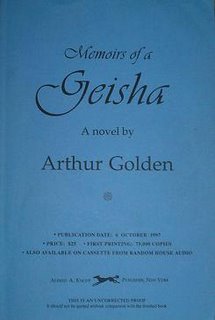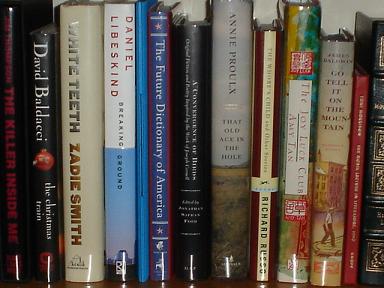Uncorrected Proofs, Bound Manuscripts, & Advanced Readers Copies
 Before the publication of novels, publishing houses bind several paperback copies of the book and distribute them internally, to booksellers, and executive producers. These bound editions have several names depending on the time they are released. These books are distributed, for free, as a sort of "early announcment" for booksellers, and they are used to garner interest from Hollywood for those interested in buying the film rights to movies.
Before the publication of novels, publishing houses bind several paperback copies of the book and distribute them internally, to booksellers, and executive producers. These bound editions have several names depending on the time they are released. These books are distributed, for free, as a sort of "early announcment" for booksellers, and they are used to garner interest from Hollywood for those interested in buying the film rights to movies.To the left is the uncorrected proof to Arthur Golden's Memoirs of a Geisha. Its fairly easy to distinguish an uncorrected proof from a bound manuscript or advanced readers copy because the proof is usually very basic in appearance. The cover is most likely a solid color with the title of the book and the author’s name. Usually on the front or back of the book, it can have information such as date of publication, first print run, and the formal announcement of the forthcoming book.
 Depending on the buyer, this is the most desirable state of proof. It's too early for the book to have any art work, and there can be some significant changes in the text of the story. For the most part, proofs differ only slightly from the actual first printing of the book. I have never heard of a proof that has a total different story conclusion from the first printing; just minor changes in facts and possible word omissions to make the story flow easier.
Depending on the buyer, this is the most desirable state of proof. It's too early for the book to have any art work, and there can be some significant changes in the text of the story. For the most part, proofs differ only slightly from the actual first printing of the book. I have never heard of a proof that has a total different story conclusion from the first printing; just minor changes in facts and possible word omissions to make the story flow easier.Since these proofs are made for mainly in house viewing, there are few made and the quality is not the greatest. The binding usually breaks easy since the glue is cheap; and the paper covers damage very easily since they are not protected in any way from damage.

In this photograph, this shows two early editions of Janet Fitch's White Oleander. On the right is the bound manuscript - the left, an advanced readers copy. The bound manuscript is the rarest of all early editions. Basically, it is a photocopy of the authors actual manuscript - before editing, before any corrections. These types of proofs are rarely made, and when they are, they are made in such limited quantity that they rarely show up for sale on the secondary market. This is, in my opinion, the most desirable of any proof. It has the type setting of the authors typewriter/computer and is, in no way changed by editors or publishers.
 To the right of the Fitch photo (and to the right of the screen) is the Advanced Readers Copy. This is the more common of all proofs and more available to buyers. This is basically what the paperback will look like once it is published. ARC's are the books have if you want to read the book early. I remember when Stephen King's The Dark Tower 7 book was due out, there was a bookstore near me selling the proof copy for well over $1,000. Not only did they sell it, but people were calling them for weeks to ask if they were getting another. The downfall is that the proof isnt worth 1/3 of the $1,000 initially paid. So basically the $1,000 is what you pay to read the book before everyone else. To some collectors – the price is cheap to read the ending to a book before anyone else.
To the right of the Fitch photo (and to the right of the screen) is the Advanced Readers Copy. This is the more common of all proofs and more available to buyers. This is basically what the paperback will look like once it is published. ARC's are the books have if you want to read the book early. I remember when Stephen King's The Dark Tower 7 book was due out, there was a bookstore near me selling the proof copy for well over $1,000. Not only did they sell it, but people were calling them for weeks to ask if they were getting another. The downfall is that the proof isnt worth 1/3 of the $1,000 initially paid. So basically the $1,000 is what you pay to read the book before everyone else. To some collectors – the price is cheap to read the ending to a book before anyone else.John Hanic, one of the leading collectors in Stephen King proofs/ARC's/manuscripts says:
"I liked the idea of being one of the very few people in the world to have read his newest work before it was officially published. All these items are issued before the initial trade printing, making them the true first printing of the book."
The flip side to collecting books is that once you have the proof from the United States...you then have to buy the United Kingdom proof (the photo above is the UK ARC to A Million Little Pieces). For the most part, collecting the UK proof can be harder if you live in the US because it’s not a common occurrence for the UK proof to show up on the market. In addition, once you are familiar with the UK proofs - you then find different variations from all over the world.
"I decided to enhance my collection by trying to get all of King’s works in their proof form. I wanted both US and UK versions. I didn’t realize just how many and varied the items are, and how scarce information is regarding these. I am continually learning of new proofs that I didn’t know existed from numerous sources," says Hanic.
I would not suggest for a beginner to start collecting proofs right away. Proofs can cost a lot of money and isn’t the wisest choice to start a collection with. Get the first edition, and if its a book you love, look for the proof. It’s a great addition to any collection and is - in fact - the rarest form of your favorite book.
